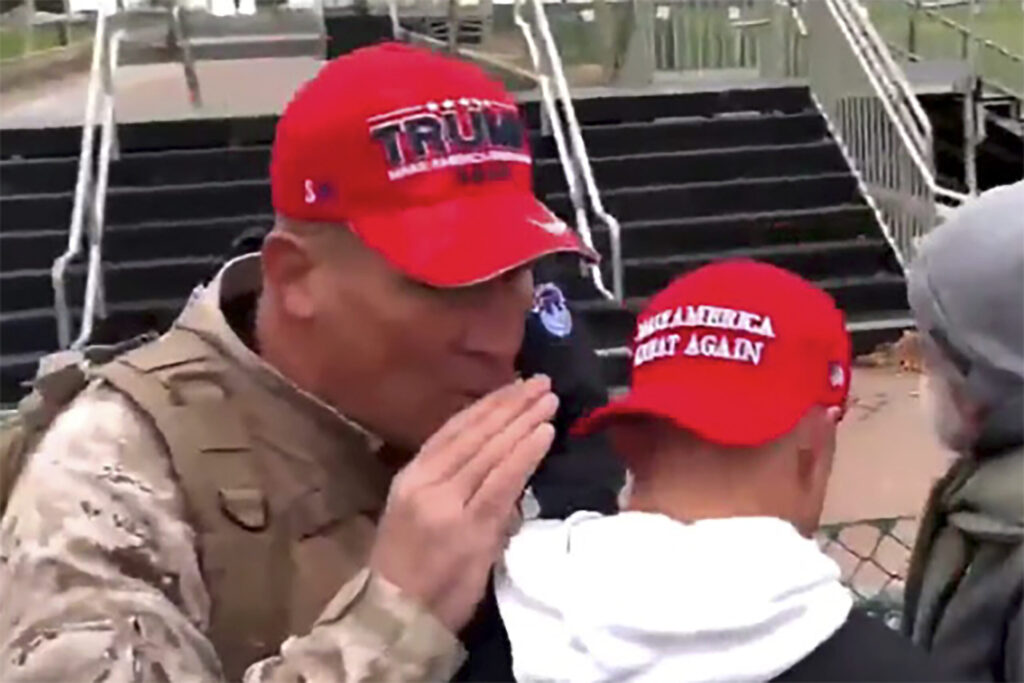On January 6, 2021, the U.S. Capitol was besieged by a mob of Donald Trump supporters, resulting in widespread condemnation and numerous arrests. Among the figures who emerged from this tumultuous day was Ray Epps, an Arizona resident whose presence at the Capitol and subsequent lack of prosecution sparked significant controversy. Initially listed among the top suspects by the FBI, Epps’s profile changed dramatically as questions arose about why he, despite his apparent involvement in inciting the riot, faced little to no legal repercussions. Epps’s case contrasts starkly with those of other individuals, like Rebecca Lavrenz, Jalise Middleton, and James Grant, who faced severe consequences for their participation. The selective prosecution narrative claims the Department of Justice, under Attorney General Merrick Garland, has been weaponized against certain groups while allowing individuals like Epps to skate by more easily.
Ray Epps, a former president of the Arizona Chapter of the OathKeepers, had an astonishingly rapid rise and fall on the FBI’s suspect list. Notably, he was initially ranked as #16, only to be removed soon after, leading to speculation about his role that day. After a prolonged period free of significant legal action, Epps was eventually charged with disorderly conduct and sentenced to just a year of probation in September 2023. Comparatively, James Grant, another participant in the events of January 6, found himself ensnared in the justice system. He faced serious charges, ultimately serving over two years in federal prison for his involvement, which included being unjustly linked as a co-defendant of Ryan Samsel, a fellow participant he did not even know.
The details surrounding Epps and his interactions on that day remain contentious. Witness testimony and video evidence suggest Epps was actively prompting the protestors to escalate toward the Capitol. For example, just before a significant breach at the bike racks, multiple accounts suggest that Epps may have instructed Ryan Samsel by saying, “We need more people.” This contrasts with later claims that he purportedly told Samsel that the police were merely performing their duties. The discrepancy presents an opportunity for critical examination of the actions leading to the chaotic incursion into the Capitol, highlighting the pivotal role Epps may have played.
James Grant’s experience encapsulates the plight of many January 6 defendants who feel they have been unjustly treated by the justice system. After graduating with honors, Grant had plans to attend law school, which were derailed due to his arrest and conviction related to the Capitol attack. He was reported as having assaulted law enforcement, a claim he disputes vehemently, as his actions were mischaracterized in connection with Epps’s prompting of the mob. Grant’s narrative sheds further light on the complexities and, perhaps, the contradictions within the Justice Department’s handling of the January 6 cases, particularly emphasizing the seeming inequality in prosecution between various participants.
Eyewitness accounts paint a vivid picture of Epps leading individuals, including individuals from the BLM movement, toward the Capitol prior to the chaos. His notorious declaration on January 5th about storming the Capitol seems to conflict with the narrative that downplays his role. Additionally, video evidence shows Epps encouraging the mob, indicating he may have played a coordinating role in the moments leading up to the Capitol breach. Meanwhile, other notable figures like John Sullivan also appeared during these pre-riot moments, raising further questions about the extent of federal engagement or surveillance in such movements.
In a dramatic conclusion to the sequence of events, Epps’s texts indicated a level of orchestration that underscored his potential complicity or guiding influence in the mob’s actions. As he reportedly texted his nephew after the attack, claiming to have been instrumental in leading the group, the statements raise alarms about the authenticity of the Justice Department’s investigations, especially in the face of conflicting narratives presented by media outlets like the New York Times. The broader implication of Grant’s story—once shackled by the weight of federal prosecution—is that there’s a narrative being supported by those in power that veers dangerously close to concealing or obscuring the complex truth behind January 6 and the individuals involved, like Ray Epps, who remain enveloped in shadow.
As the scrutiny around that day continues, particularly surrounding Ray Epps and others, it’s clear that there are unresolved questions regarding accountability and justice. James Grant’s recent willingness to speak reveals a climate where fear previously muted dissenting voices and perspectives. The rich interactions, active involvement, and, at times, troubling patterns emerge from the fog of that fateful day, suggesting significant layers to the events that unfold beyond simple narratives of guilt or innocence. As more voices, like Grant’s, rise to present their accounts, there’s an opportunity for greater clarity regarding the motivations, actions, and indeed, the role of those like Epps, and whether they were merely participants or something more orchestrated in a deeply polarized political landscape.

